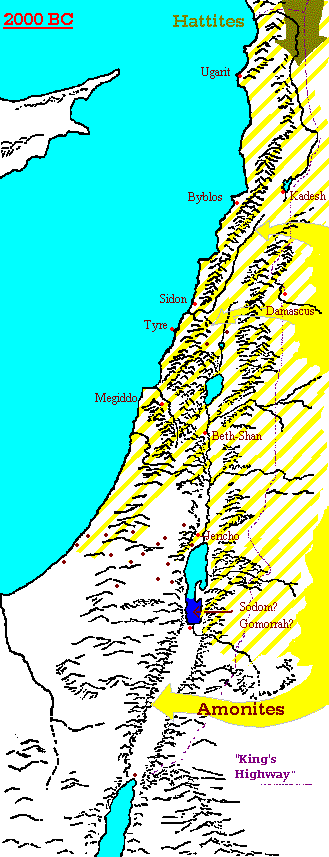Prepare Ye the Way
2000 - 1900 BC, the Holy Land
2000 - 1900 BC, the Holy Land
 Abraham and his household moved into Canaan and even briefly entered Egypt, whose borders were expanding northward again by mid-century.
As peaceful nomads, the newcomers would have been no trouble to Egypt, whose interests centered on the prosperous cities of the coast like Byblos and Sidon or granaries like Beth-Shan, not so much on the small towns and tribes of the interior.
Abraham would not have been unusual among those people, who included Hattites (pre-Hittite Anatolians), ancient Canaanites, Amorites whose forefathers had conquered the coastal cities a couple of centuries earlier, and the new wave of Amorite nomads.
Over the eons these people had drifted into the land and stayed there.
Settlements flourished about this time in the Transjordan, as well.
Towns could even be found south toward the Gulf of Aqabah, profiting from the rich copper mines of that area.
Abraham and his household moved into Canaan and even briefly entered Egypt, whose borders were expanding northward again by mid-century.
As peaceful nomads, the newcomers would have been no trouble to Egypt, whose interests centered on the prosperous cities of the coast like Byblos and Sidon or granaries like Beth-Shan, not so much on the small towns and tribes of the interior.
Abraham would not have been unusual among those people, who included Hattites (pre-Hittite Anatolians), ancient Canaanites, Amorites whose forefathers had conquered the coastal cities a couple of centuries earlier, and the new wave of Amorite nomads.
Over the eons these people had drifted into the land and stayed there.
Settlements flourished about this time in the Transjordan, as well.
Towns could even be found south toward the Gulf of Aqabah, profiting from the rich copper mines of that area.
The household of Abraham prospered and it became time to divide the group. His nephew Lot chose the area of the Jordan, settling "toward Sodom", of the Plains of Siddim, while Abraham moved to the highlands to the west.
The southern Transjordan east and south of the Dead Sea, though largely desert today, was settled and cultivated before about 2000 BC.
Sodom, Gomorrah, Admah, Zeboiim and Zoar have vanished, but they are described in Genesis as prosperous cities of the plain. They were attacked in those years by a coalition of kings from the fracturing empire of Sumer, possibly including kings of Elam, Hatti and Larsa. Maybe, as was to happen many times again, tributary cities were taking advantage of weakened overlords and declaring a premature independence.
Posted by John  Read more
Read more  Comments (15)
Comments (15) ![]() 17.01.
17.01.